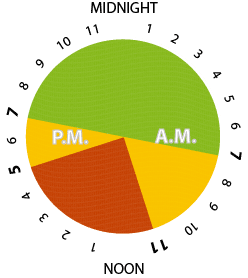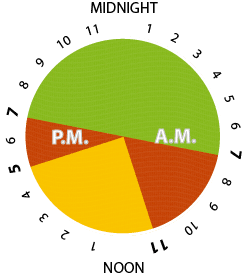Time of Use
The majority of our residential and small business customers pay Time-of-Use (TOU) rates and prices for their electricity. These rates are set by the Ontario Energy Board.
What is Time-of-Use?
The Time-of-Use rate is a plan in which rates vary according to the time of day, season, and daytime (weekday or weekend/holiday). Higher rates are charged during peak demand hours and lower rates during off-peak (low) demand hours. Rates are also typically higher in summer months in comparison to winter months.
Time-of-use rates are different depending on when you use electricity. There are three periods:
- Off-peak: This is when demand for electricity is the lowest. Ontario households and small businesses use the majority of their electricity- nearly two thirds of it- during off-peak hours.
- Mid-peak: when demand for electricity is moderate. These periods are during the daytime, but not the busiest times of day.
- On-peak: When demand is highest. These are the busiest times of day-generally when people are cooking, starting up their computers and running heaters or air conditioners.
Why do these rates vary?
The TOU rates vary according to demand. Demand tends to be lowest during the evenings, on weekends and on holidays.
In Ontario, when demand is lower, most of the power we use comes from sources like nuclear generators and large hydroelectric stations, which are designed to run all the time. This is called baseload power.
As daylight begins, more people turn on their lights and appliances, and businesses ramp up their operations for the workday. These are high demand times for electricity. When all baseload power is used, the province turns to other source like natural gas-fired generation, which typically costs more than baseload.
Summer and Winter Rate Periods
Since people use electricity differently depending on the season, there are two sets of time-of-use rate periods: summer and winter.
Please note that regardless of the season, weekends and holidays have the cheapest rates in effect all day.
The current TOU pricing is as follows:
| Off-Peak: 7.6 cents/kWh | Mid-Peak: 12.2 cents/kWh | On-Peak: 15.8 cents/kWh |
Please note that the rates quoted above are as of November 1, 2024 and relate only to the electricity cost on your bill. They do not include delivery, regulatory charges or the debt retirement charge. See the current TOU period and price on the Ontario Energy Board website.
Summer Weekdays
Summer Time-of-Use rates are set from May 1 to October 31 in any given year. In the summer, electricity use peaks during the hottest part of the afternoon, when air conditioners are running on high. On-peak hours are mid-day.

- Off-peak: 7pm – 7am
- Mid-peak: 7am – 11am and 5pm – 7pm
- On-peak: 11am – 5pm
Winter Weekdays
Winter Time-of-Use rates are set from November 1 to April 30 in any given year. In the winter, less daylight means electricity use peaks twice: once in the morning when people wake up and turn on their lights and appliances, then again when people get home from work. There are two sets of on-peak hours to reflect this.

- Off-peak: 7pm – 7am
- Mid-peak: 11am – 5pm
- On-peak: 7am – 11am and 5pm – 7pm
2025 Holiday Schedule of Off-Peak Pricing
Please note Off-Peak pricing applies to holidays and weekends. The 2025 Holiday Schedule of Off-Peak Pricing is as follows:
| Day | Holiday |
|---|---|
| Wednesday, January 1 | New Year’s Day |
| Monday, February 17 | Family Day |
| Friday, April 18 | Good Friday |
| Monday, May 19 | Victoria Day |
| Tuesday, July 1 | Canada Day |
| Monday, August 4 | Civic Holiday |
| Monday, September 1 | Labour Day |
| Monday, October 13 | Thanksgiving Day |
| Thursday, December 25 | Christmas Day |
| Friday, December 26 | Boxing Day |
Easter Monday is not a holiday recognized by the Ontario Energy Board. Regular time-of-use rates apply to this day.
